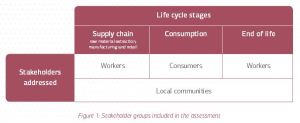Filed under: Directions for Sustainable Innovation | Tags: green marketing, Marketing, Premium, Sales

‘How do you sell sustainability?’ is one of the most challenging questions today. Imagine this: You have just developed a great new product with clear, measurable environmental benefits. After the product launch, you expect to see the sales skyrocket. But they don’t.
What went wrong? Did you overlook something? Why are these new products, which are obviously better for the environment and better for people, not selling? There are a number of myths around selling sustainable products that you need to know. Understanding these misconceptions will help you find the best possible arguments, get full value out of your sustainability claims and improve sales.
Myth #1: Sustainability will sell itself
Many people assume that sustainability will conveniently translate to higher margins. Unfortunately, this often does not work out in practice. Maybe your customers want your products to be green, but they don’t emphasize this. In some cases, sustainability is a unique selling point but only ranks 4th or 5th on the list, and only when framed in a very customized way. On a positive note, research shows 65% of consumers are willing to pay more for products with an environmental or social benefit. It is important to take a systematic approach to make full use of the sustainability benefits. Different customer group may care about different specific social and environmental causes. If you understand these causes and know how to articulate these benefits well, you have good chances. One interesting approach is the WRI SHIFT model.
The truth: You have to take a systematic approach to study your customers’ needs and concerns and then frame your message accordingly.
Myth #2: Telling a good story will do
We live in an age of storytelling. Many of us are even trained to do so in a compelling way. Some share personal breakthrough moments to underline their commitment to sustainability, others use stories of their organisation to open the door to have a meaningful conversation. Stories are very powerful ways to bring up a topic. However, when it comes to sustainability, and the story lacks proof points and fails to make a connection with the world as viewed by your target audience, it will not resonate.
The truth: You must connect your sustainability story with your customer concerns and use verifiable facts and figures related to your business and products
Myth #3: Carbon footprint is the silver bullet
You may have put some work into calculating the carbon footprint of your product. This provides great information however it says little about other topics such as freshwater use, the protection of forests, or labour rights. Climate action is key to reduce the worlds greenhouse gas emissions. Carbon footprint is a very important but only one aspect of sustainable development.
The truth: You must look at the big picture when it comes to sustainability. Understand the complexities, and assess the full environmental and social impact of your product.
Myth #4: Sustainability is a nice extra
Having a sustainability strategy in place is a great asset. It will boost employee engagement and contributes to a feel-good factor It is a misconception however to see sustainability only as a nice add-on, something extra that you might as well leave out. For many organisations environmental and social performance have become a licence to do business, close to a hygiene factor. People use different benchmarks or labels to come to their decision to buy specific brands or products. Companies look for suppliers that demonstrate high performance in industry sustainability benchmarks. It is essential to understand which sustainability issues exactly motivate your customers and align your R&D, product portfolio and marketing accordingly.
The truth: You need to have a solid understanding of your customers’ key sustainability indicators and potential differentiators, then build that into your value proposition.
Myth #5: Just go for the millennials
Millennials continue to drive consumer trends when it comes to sustainability and purpose-driven companies. According to a recent Nielsen study, millennials see “the orientation on purpose as an important shopping criterium”. So, many businesspeople think, “We should target millennials in our product placement! Spread the news and our product will fly off the shelves!” Not so fast. The Millennials group is not an easy target audience persé, nor a homogeneous group. Besides, not only millennials are interested in social and environmental causes connected with products and services. It is an illusion to think that Millennials will immediately buy your product because of the ‘good cause’ you support. Besides it makes sense to carefully explore the market landscape beyond Millennials. Environmental and social causes are certainly also of importance for the Babyboom generation, Gen X and Gen Z, although this might be for slightly different reasons (leaving a legacy, setting the example for kids, etc.).
The truth: You should define your target audience and their interest in environmental and societal goals in detail, then shape your marketing and channel strategy accordingly.
Conclusion
Addressing environmental and social causes can bring promising new avenues to market and sell your products better. It provides a great source for inspiration and excitement – but keep in mind a single magic formula to sell sustainable products does not exist. It’s a question of thorough customer understanding, integrating meaningful environmental and social causes in your value proposition, and applying your best marketing & sales skills. This will help you to better sell your sustainable products for the benefit of society and business.
Filed under: Directions for Sustainable Innovation, Sustainability News, Your customers want your products to be green | Tags: Business Disciplines, Control, Engagement, Human Resources, Innovation, Marketing, Organizations, Purchasing, Sales, Sustainability
Sustainability knowledge and tactics will be diffused accross organizations. It will be embedded in all functional areas. Which is a great thing.
All disciplines will be affected. Employees will need to be involved and trained in new areas that are logical extentions of their current activities, but with a sustainability focus:
- Marketeers will be inspired by the new market dynamics related to environmental and social issues. All marketeers will learn about what works and what won’t in Green Marketing.
- Innovators will be challenged to develop new products that create user benefits ánd create a positive social change, with reduced ecological impact
- Sales reps will be trained to identify customer sustainability expectations and convince them of the advantages of new business models.
- Purchasing will intensify at one hand the sustainable supplier criteria and audits, and at the other hand the cooperation with suppliers to search for sustainable sourcing solutions.
- Controllers will be asked to track progress against social and environmental parameters in addition to the traditional financial indicators.
- Human Resources have already discovered the power of Sustainability as a means to attract and retain employees. They will be encouraged to develop engagement plans and bonus plans that include sustainability performance indicators.
All functions will be affected. Yet a small group at headquarters will need to stay in place. This central sustainability team will be there to overview and align the companies sustainability activities, share best practices, set the companies KPIs, benchmark and track market developments and update the sustainability strategy accordingly.
More information on sustainability developments and best practices in my book ‘Your customers want your products to be green’. The book contains insights based on interviews with 19 senior sustainability & CSR managers of European frontrunners. Let me know what you think about it!

